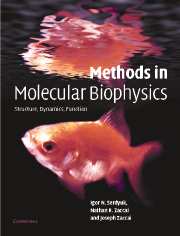Book contents
- Frontmatter
- Contents
- Foreword by D. M. Engelman
- Foreword by Pierre Joliot
- Preface
- Introduction: Molecular biophysics at the beginning of the twenty-first century: from ensemble measurements to single-molecule detection
- Part A Biological macromolecules and physical tools
- Part B Mass spectrometry
- Part C Thermodynamics
- Part D Hydrodynamics
- Part E Optical spectroscopy
- Part F Optical microscopy
- Part G X-ray and neutron diffraction
- Part H Electron diffraction
- Chapter H1 Electron microscopy
- Chapter H2 Three-dimensional reconstruction from two-dimensional images
- Part I Molecular dynamics
- Part J Nuclear magnetic resonance
- References
- Index of eminent scientists
- Subject Index
- References
Chapter H1 - Electron microscopy
from Part H - Electron diffraction
Published online by Cambridge University Press: 05 November 2012
- Frontmatter
- Contents
- Foreword by D. M. Engelman
- Foreword by Pierre Joliot
- Preface
- Introduction: Molecular biophysics at the beginning of the twenty-first century: from ensemble measurements to single-molecule detection
- Part A Biological macromolecules and physical tools
- Part B Mass spectrometry
- Part C Thermodynamics
- Part D Hydrodynamics
- Part E Optical spectroscopy
- Part F Optical microscopy
- Part G X-ray and neutron diffraction
- Part H Electron diffraction
- Chapter H1 Electron microscopy
- Chapter H2 Three-dimensional reconstruction from two-dimensional images
- Part I Molecular dynamics
- Part J Nuclear magnetic resonance
- References
- Index of eminent scientists
- Subject Index
- References
Summary
Historical review
J.-B. Biot and F. Savart collaborated on the theory of magnetism. Their eponymous law (formulated in 1820) describes the motion of a charge in a magnetic field.
Ernst Abbe in 1872 formulated his wave theory of microscopic imaging. In 1878, he was able to correlate resolution and wavelength of light mathematically. A few years later, through the company Zeiss, he commercialised the first ever lenses to have been designed based on sound optical theory and the laws of physics.
In the second half of the nineteenth century, J. C. Maxwell established the laws of electromagnetism. His equations first appeared in fully developed form in his book Electricity and Magnetism (1873).
In 1897 J. J. Thomson discovered electrons by demonstrating cathode rays were actually units of electrical current made up of negatively charged particles of subatomic size. For these investigations he won the Nobel Prize for physics in 1906.
In his doctoral thesis of 1924, de Broglie theorised that matter has the properties of both particles and waves. He received the 1929 Nobel Prize for physics. The particle–wave duality was confirmed experimentally, for the electron, a few years later by C. J. Davisson and L. H. Germer and by G. P. Thomson. Thomson and Davisson jointly shared the Nobel Prize in physics in 1937.
In 1926 H. Busch described a lens for electrons. H. Ruska subsequently built the first working electron microscope in 1930 (Nobel Prize in 1986).
- Type
- Chapter
- Information
- Methods in Molecular BiophysicsStructure, Dynamics, Function, pp. 885 - 903Publisher: Cambridge University PressPrint publication year: 2007



